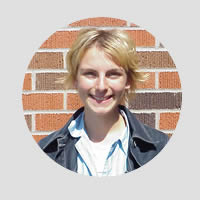|
Dianna Fairchild

Dianna Fairchild
Nature and all of its inhabitants have always enthralled me.
As I got older, these interests were nurtured and I began to
focus on them. I grew up on the outskirts of the city of Columbus
in Ohio ; where there were no natural places still remaining.
Therefore, I watched television shows and read books that were
geared to various aspects of nature to acquire additional knowledge
in ecology and wildlife biology. My desire to increase my knowledge
in these subjects led me to a major in Wildlife Biology after
high school graduation. Unfortunately, Ohio State University
was not a college conducive to my needs therefore I decided
to continue my education at Columbus State Community College
in the field of Veterinary Technology where I received an Associates
of Science degree.
My determination to find a place that was not only conducive
to my desire for wilderness and wildlife but also to a college
that offered a major in Wildlife biology never diminished.
I found this and more in Missoula , Montana at the University
of Montana . Not only did I find a plethora of wilderness and
wildlife but in addition I happened to attend a college renowned
for its College of Forestry and Conservation. I am preparing
to graduate with a B.S. in Wildlife Biology at the end of the
summer (2004) and from there I will continue my education with
a B.A. in Biology as well as Secondary Teaching Certificates
in biology and general science.
Throughout my college career I have had numerous opportunities
to assist in and conduct research. I have worked with various
wildlife species in different habitats including; mark and recapture
surveys for small mammals, bark gleaning and nest searching surveys
for several bird species, visibility measurements for big horn
sheep, wolf tracking, and research regarding the indirect effects
of spotted knapweed (Centaurea maculosa) on various
insects and animals. I am completing my senior thesis on the
effects of spotted knapweed on grassland bird foraging. I am
excited to be a part of the ECOS fellowship and am looking forward
to this rewarding experience.
|
|
Frank Janes

Frank Janes
I became interested in ecology as I learned about the role
of microbes in sustaining life on earth. It was intriguing
to me that vital processes such as nutrient cycling, which
is necessary for the survival of all higher organisms, was
primarily dependent on the complex interactions of microscopic
organisms. I originally came to the university to become
a pharmacist, but my interest in science led me to switch my
major to microbiology with the intention of going on to medical
school after getting my degree. My research experience
thus far consists of volunteering in an immunology lab on campus
with Chris Migliaccio Ph.D, who studies the effect pollutants
like silicon have on alveolar macrophages in mice. My
work experience there, along with the influence of a few excellent
professors, has sparked my interest scientific research.
|
|
Sarah Keller

Sarah Keller
My path to ecology started in rural Maryland and West Virginia
where I was a barefooted and reptile-chasing kid. As a teenager
I warmed up to the nuances of botany while roaming the hills
and drainages of West Virginia . One of my favorite places
in the state was the Dolly Sods Wilderness, a high, boggy plateau
that looks like northern Canada and is home to many plants
at the southern end of their range, including aspens. Among
my favorite habitats were those dominated by Eastern Hemlock
or Balsam Fir, currently under devastation by insects called
adelgids. Such problems contribute to my increasing interest
in plant-insect interactions from applied and ecological/evolutionary
perspectives.
When I started homeschooling at 15 I spent much time envying
our early naturalists. As a remedy I volunteered myself to
the scientists at the Blandy Experimental Farm in Virginia
before and during college. I worked for Dave Carr and his postdoc
Chris Ivey both of whom study inbreeding depression in Mimulus (Monkeyflower) . The
kind folks at Blandy gave me exposure to ecology and tons of
experience. Dave is also an avid birder and I credit
him for sending me down the path to compulsive bird chasing.
During the summer of 2002, Chris advised me in research where
I studied plant-pollinator xinteractions and in 2003 I worked
on another pollination biology project dealing with Penstemons at
Rocky Mountain Biological Lab in Colorado . I will be back
high in the Colorado Rockies briefly this summer studying interactions
between sapsuckers, swallows and heartwood fungus in aspen
forests. Besides birds and flowering plants, fungi and ferns
are high on my list. But I have to admit that when it comes
to biodiversity my taste is not discriminating!
From West Virginia I transferred to the University of Montana
in September of 2003. Currently, I am thinking about the myriad
of systems I could adopt for graduate study, considering spending
time in South America , finishing up my biology degree and
enjoying immensely the natural history and mountains of the
West.
|
|
Lauren Priestmann

Lauren Priestmann
My Grandmother was a world traveler in the 1950's, and as
a child, these were my favorite bedtime stories. She inspired
me to follow in her footsteps and explore different environments
and lifestyles as a young adult. For several years, and much
to my parent's chagrin, I set out to explore cloud forests
and deserts, high mountains and rivers. I worked seasonally
at a variety of jobs to fund these trips, and the combination
of interesting jobs and faraway travels was an exhilarating
experience in and of itself. As a naturalist at the Grand Canyon,
I was captivated by the striking differences between the landscapes
there compared to that of my home in Rhode Island. As a caretaker
and landscaper at a garden center, I gained a true love of plants. I voyeuristically
watched the relationships and subtle changes in the wilderness over two seasons
as a wilderness ranger in the Beartooth Mountains of Montana. Ski instructing
in the winter provided me with a forum to share a skill with my students that
would entice them to spend more time in the outdoors. My curiosity about the
interrelationships between living creatures and their environment grew with
each new experience. My next step seemed natural: to filter this wanderlust
into something more constructive. I decided that a degree in ecology at the
University of Montana could be an elegant match with my first degree in Communication
Studies from the University of Massachusetts. It is my hope to couple my experiences
thus far with innovative scholastic tools into a career teaching ecology creatively
and hands-on, in an inspirational environment.
In addition to the ECOS project, I am currently working on
a project with the Rocky Mountain Research Station as a plant
ecologist. This research, titled Exotic Plants and Forest
Restoration Treatments: Effects on Flora and Fauna of the Northern
Rocky Mountains , seeks to explore the effects of weed
eradication treatments used in Western Montana on community
structure over multiple trophic levels.
|
|
Hollie Sexton

Hollie Sexton
My name is Hollie Sexton, and I am a biology student at the
University of Montana with an emphasis in pre-medical studies.
Since my childhood days digging in the mud and snow of Alaska
and Western Washington, I have been fascinated by the biological
sciences and ecology in particular. Although, back then ecology
was chasing moose off my front porch and catching sea stars
in the tide-pools. After we moved down to the lower forty-eight,
it was through classes in my high school that I continued to
study and learn about ecology. It was Ms. Lawi who first got
me interested in the academic portion of the life sciences.
She made books and nature mesh in a way that was practical
and hands-on and helped me understand nature on a whole new
level. Before attending the University of Montana, I guess
you could say that I bounced around a fair amount. First, I
studied at Clark University near my family's home just outside
of Portland , Oregon . Then I transferred to the University
of Nevada-Reno. After a year and a half there, I decided to
study abroad in Santiago , Chile . When I was done there, I
enjoyed Spanish so much, I studied abroad again in Barcelona
, Spain . I suppose all this traveling seems a little out of
the way, but I really felt like I wanted to see the world before
I settled down to pursue one single thing. And, for the record,
I'm glad I did. Since I've been here in Missoula, I've worked
as a lab technician in the Wild Trout and Salmon Genetics lab,
working on conservation issues of the fish in our watersheds,
and I have led the human dissection team for the Anatomy and
Physiology class. Whether I am hiking in the Bitterroots, sitting
in class or working in the lab, I am constantly trying to better
understand the Ecology of our world and Missoula . I still
love learning about everything that affects our lives, from
frogs to microorganisms, to rain fall and am excited to share
this passion with other students in the coming year.
|
|


 Funded by the National Science Foundation
Funded by the National Science Foundation